KIDS & MUSIC - A Perfect Connection through SUZUKI METHOD - Part 2
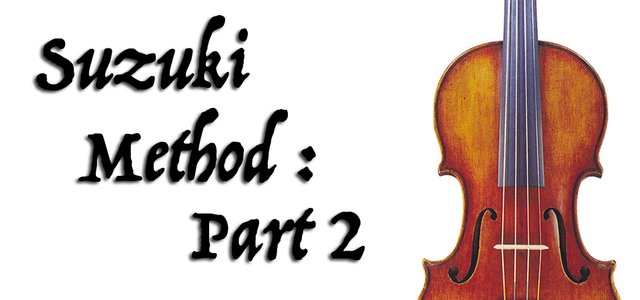
In the previous post I explained, in rough outlines, three essential points to understand the Suzuki Method philosophy. In this second one I’ll give you a more theoretical version that will make you understand how Shiniche Suzuki tried to contribute with a new classical music learning method.
Point four, what is it based on?
Every child can
The same way that a child doesn’t need a special talent to learn a mother tongue, given that all of them have the intelligence and capacity to achieve it, every child can learn to play an instrument. The talent is not innate, but can be learned and developed, being the environment the main key: family, education, partners, etc. Although some innate qualities can change, as speed or the way of learning, we can affirm that EVERY CHILD CAN!!!

Beginning at early ages
Early years are crucial in the development of mental processes and muscles coordination in little children. Their hearing capacities are also in a decisive point during the language acquisition years, so it’s the perfect moment to develop the music sensitivity. Children should begin listening to music at birth, starting the formal training at the age of three or four, but it’s true that it’s never late to start.
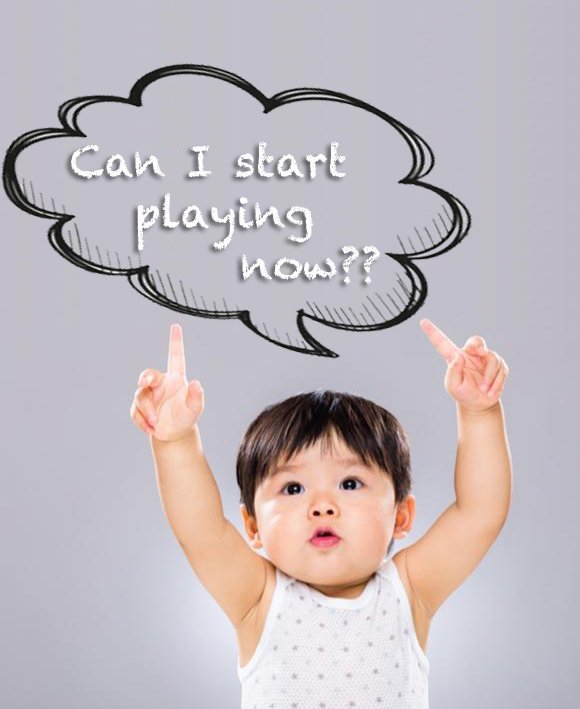
Listening
Children learn to say their first words after hearing them spoken hundreds of times by others. In an instrument learning process it’s vital that children listen the pieces they’re going to study countless times, as well as any other good quality music.
Suzuki’s repertoire is composed by a series of books, divided by instruments, in different volumes. All pieces in these books are recorded in order to make children learn them, at least at the beginning, by hearing imitation, as well as happens in their mother tongue learning process.
The experience shows that, the more they listen the pieces in the Suzuki volumes, the faster they play those pieces.
It is important to take into account every child personal characteristic, their environment and education make that (despite of their albums hearing dependence) every child develops a unique and unrepeatable way of expressing and performing music. This hearing development increases, at the same time, the memorization capacity and expands the awareness for the stile and the musical performance.

Repetition
When children learn a word, they don’t let it, they keep using it at the time they add new words to their vocabulary. The same way, Suzuki’s students repeat the pieces they learn, adding gradually the skills they’ve been gaining of new and more sophisticated ways as they increase their repertoire.
When new technical abilities and musical concepts are added in the context of already learnt pieces, there’s an easier acquisition of these. It’s also true that, given to this, the learning of more complicated pieces can be difficult, because children are learning primarily to imitate instead of performing.
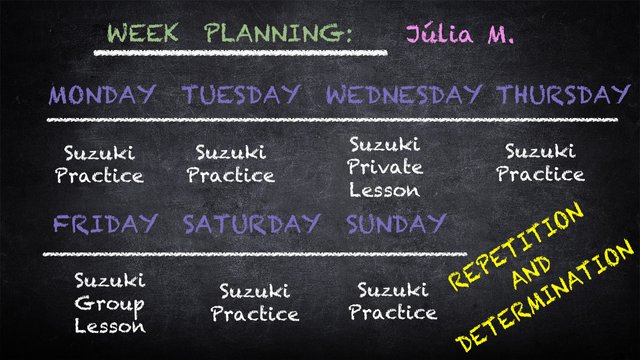
Motivation
The same way as happens with the mother tongue, the sacrifices children do to learn how to play an instrument have to be praised with sweet words of encouragement. Every child has a learning speed, improving step by step to get to the point where they control all those steps, creating a pleasant environment for the kid, father and teacher. This situation establishes an atmosphere of generosity and cooperation that take children to support the efforts made for other children.

Learning among other children
It’s proved that music fosters healthy social interactions. The same way, it’s known that participating in group lessons or small concerts, apart from the individual lessons, is an excellent motivation for children. They enjoy observing other children at different levels, aspiring to get the higher level’s students, sharing their own challenges with their partners and appreciating the sacrifices of those who are in lower levels trying to give the steps they’ve already given.
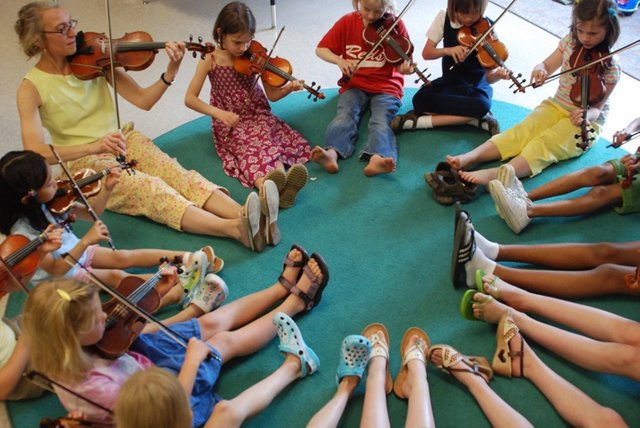
Graded Repertoire
Children don’t practice specific exercises to learn to talk, but learn using the language for its natural purpose of communication and self-expression. The Suzuki Method makes their students learn new musical concepts and skills in the own music context, instead of practicing using exclusively technical exercises. Suzuki’s repertoire presents, for each instrument, a extremely ordered and graded sequence that provides the needed components for the technical and musical development. Again, a standard repertoire that gives a huge motivation for children, given that younger students desire to play the pieces they listen from the higher levels students.
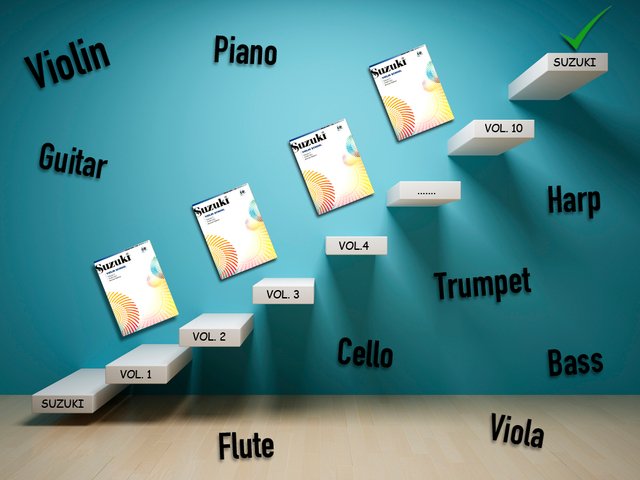
Delayed Reading
In a mother tongue learning process, children don’t learn to rear until their ability to talk has been well established. In the same way, children that study the Suzuki Method are not taught to read music until they develop basic technical competence on their instruments. It’s a teaching-learning system that allows the teacher and the student to focus in maintaining a right posture and develop a beautiful sound, with correct tuning.
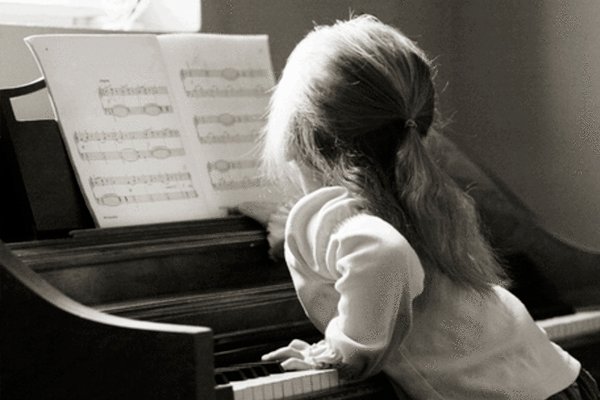
Parents Involvement
When children are learning to talk, parents act, in an innate way, as kid’s teachers. The Suzuki Method extrapolates this situation to the instrument learning process, making parents home teachers during the week. Parents involvement, extremely important in this method, make them learn how to play the instrument at the same time or even before the child, with the main purpose that children know what’s expected of them. In this case, the mother or the father must attend to the individual lessons with the child and both have to practice at home every day what they’ve learnt at those lessons.
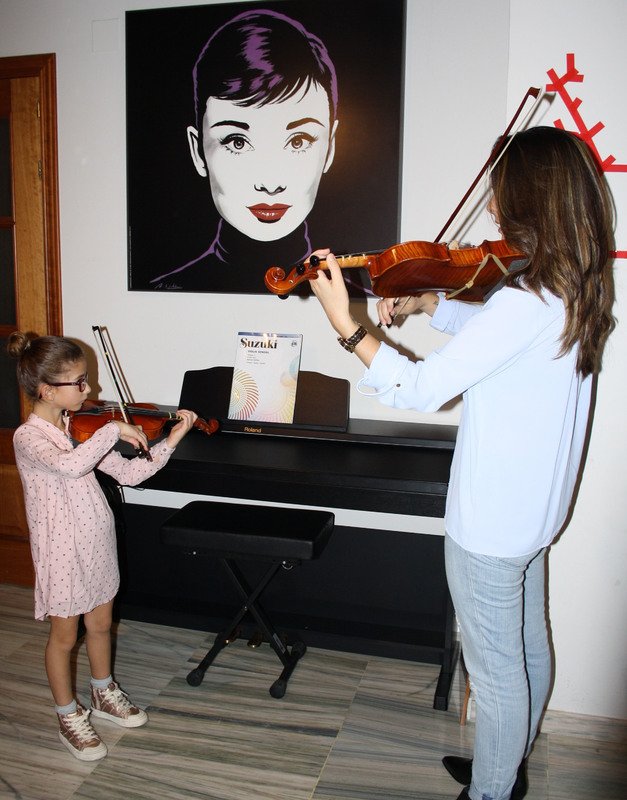
Finally, what’s the Suzuki Triangle?
In geometry, an equilateral triangle is a regular polygon, which all three sides are equal in size and importance. The same happens in the Suzuki Method: CHILD, TEACHER AND PARENTS are equally important. As well as happens in the mother tongue learning, parents involvement is essential in order to learn how to play an instrument.
Teacher must also teach the father or the mother to be the teacher at home. That’s why is absolutely necessary that they attend to lessons with the child. In this lessons they have to focus on making notes, understand everything and, in case there’s something they don’t understand, ask the teacher without interrupting the lesson dynamic.
This triangle, this participation and communication between child, parents and teacher serves as solid base to create the perfect atmosphere of motivation and love for the study.
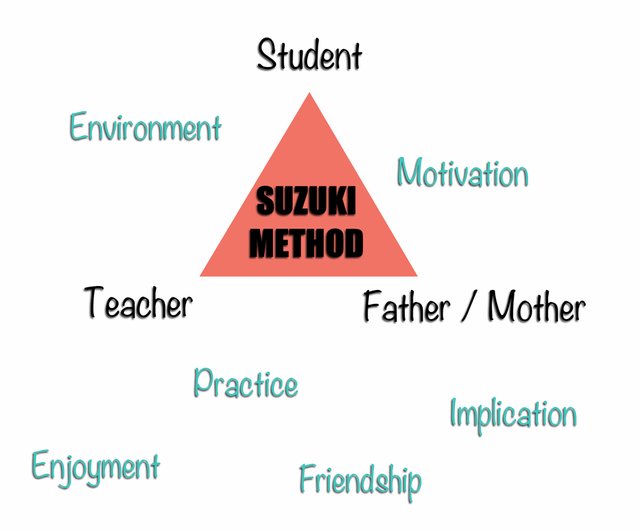
And that’s how we end with the Sukuzi Method theoretical explanation. From now on I’ll focus on the practice, my experience as a ‘Suzuki Father’ from the inside. I’ll tell you, among other stuff, the amazing feeling I had we I saw Júlia playing her little Violin in the ‘Palau de la Música’ in Barcelona, in the ‘Commemorative Concert for the 70th Anniversary of the Suzuki Method’, with amazing guest artists as Koji Toyoda.
Image Credits [1] [2] [3] [4] [5]
Thank you for the info. Never could keep my daughter interested in piano or instruments. I'll look into this
It's another way to get them connected to music. Let me know if you need more information.